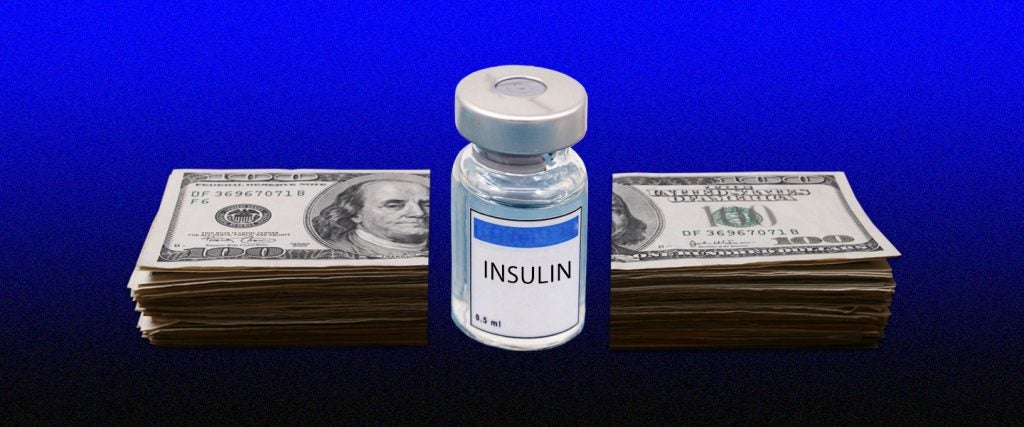When it comes to pharmaceutical fuckery, insulin is the ultimate example. Today, well over seven million Americans with diabetes need it, yet a single vial — which might last for about a week — can cost more than $300 (that same vial costs somewhere between $2 and just over $6 to produce, numbers that insulin manufacturers debate). As a result, more than 25 percent of adults with diabetes have resorted to rationing their insulin, with sometimes deadly outcomes. Meanwhile, insulin manufacturers profit billions annually.
If you’ve never known someone with diabetes, it’s hard to comprehend just how integral insulin is to them staying alive. I once dated someone with the condition, and her life was an infinite cycle of pricked fingers, blood sugar tests and insulin injections. If she had an unexpected snack, she’d need another dose. For someone like her, insulin is as important as breathing.
So, how did we come to the point where pharmaceutical companies are charging so much for insulin that people with diabetes are crossing the border into Mexico and Canada to buy it for cheaper, resorting to the black market or, in fact, dying because they can’t afford it?
The answer doesn’t have much to do with how complicated insulin is to make. In fact, some might say it’s relatively easy as far as drug production goes — nowadays, it can be grown in common bacteria like E. coli or yeast with the help of some heavy laboratory equipment. While there’s certainly a big upfront cost necessary to build factories that are capable of pumping out insulin at a financially-viable scale, the process itself is something that biology labs around the world should all be able to accomplish.
Instead, the main reason why insulin is so expensive is because there’s simply no competition to drive the price down. Ninety percent of the global insulin market is owned by three companies: Novo Nordisk, Eli Lilly and Sanofi. Couple this with the complicated web of American health care — including insurance providers that also profit from high insulin prices — and you end up with a bunch of Martin Shkreli-types who see no reason to sell their product for cheaper. It also doesn’t help that the FDA refuses to regulate drug prices, and that because insulin is a biological product, it’s difficult to get approval for a “generic” version (although, the FDA just recently approved one, so hopefully that helps cut costs).
As a result of all this, a group of biohackers known as the Open Insulin Foundation have taken it upon themselves to battle the monopoly by developing the world’s first open-source insulin production model after a series of volunteer-led experiments. They’ve already succeeded in seeing the procedure all the way through to a finished product — again, with the right equipment, the process isn’t that convoluted — and they estimate that if all goes to plan, they can produce vials for as low as $5 to $15 a piece. If they manage to achieve FDA-approval (which will be difficult, since the FDA generally frowns upon biohacking), they promise to release their model for community-level insulin factories that can operate wherever there’s a need, meaning fewer people will need to rely on the greedy Big Pharma bastards.
Furthermore, the Open Insulin Foundation believes that follow-ups on their work could include “home-brewed” insulin — in other words, insulin that an individual with diabetes could make at home for their own personal use.
The Open Insulin Foundation isn’t the only group of people to have this idea. Ryan Bethencourt, a well-known biohacker, proposed home-brewed insulin back in 2015, although not much has come of it. Likewise, in 2019, a group of biohackers claimed they were making cheaper copies of Glybera, a million-dollar gene therapy drug, in sheds, warehouses and their very own bedrooms. In general, biohacking has grown as scientific equipment and technology have become more accessible to the average person.
While many medical professionals agree that the costs of drugs like insulin are wildly out of control, they’re split on whether biohacking is the answer — obviously, if amateur scientists are involved and drugs aren’t made just right, they could end up being downright dangerous. Or worse, an individual attempting to home brew their own insulin could mistakenly release a deadly pathogen into the world. Still, unless the FDA steps in somewhere — whether that means forcing Big Pharma to reduce prices or helping biohackers make viable products — clandestine biologists are inevitably going to keep trying to get expensive medications into the hands of people who need them.
Of course, even though the Open Insulin Foundation has had success so far, there’s no doubt they still have a long road ahead of them — namely, there’s almost no chance that the big three insulin manufacturers will go down without a fight. But if they pull through, life will become infinitely better for diabetes sufferers everywhere.

